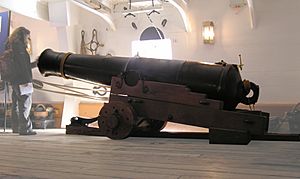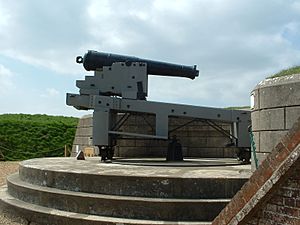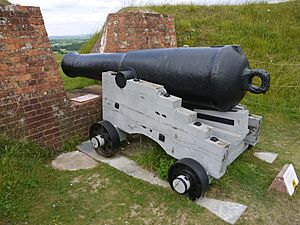68-pounder gun facts for kids
Quick facts for kids 68-pounder smoothbore cannon |
|
|---|---|

Replica 68-pounder aboard HMS Warrior.
|
|
| Type | Naval gun Coast Defence gun |
| Place of origin | United Kingdom |
| Service history | |
| In service | 1846–1921 |
| Used by | United Kingdom |
| Wars | Crimean War |
| Production history | |
| Designer | William Dundas |
| Manufacturer | Low Moor Ironworks |
| Unit cost | £225 |
| Produced | 1841–1861 |
| No. built | In excess of 2,000 |
| Specifications | |
| Mass | 88, 95 or 112 cwt |
| Barrel length | 88 cwt: 9 feet 6 inches (2,896 mm) 95 cwt: 10 feet (3,048 mm) 112 cwt: 10 feet 10 inches (3,302 mm) |
| Crew | 9 – 18 |
|
|
|
| Shell | Solid Shot Explosive Shell |
| Shell weight | 68 pounds (30.84 kg) |
| Calibre | 8.12 inches (20.62 cm) |
| Elevation | 0 – 15 degrees |
| Muzzle velocity | 1,579 feet per second (481 m/s) |
| Effective firing range | Approximately 3,000 yards (2,700 m) |
| Maximum firing range | 3,620 yards (3,310 m) |
The 68-pounder cannon was a powerful weapon used by the British military in the mid-1800s. It was a type of smoothbore gun, meaning the inside of its barrel was smooth. This cannon was loaded from the front, which is called muzzle-loading.
It was known for firing heavy projectiles that weighed about 68 lb (31 kg). Many different versions were made, but the most common one weighed about 95 long cwt (4,800 kg). This cannon was designed by Colonel William Dundas. It was used by the Royal Artillery and the Royal Navy during the Crimean War. More than 2,000 of these cannons were built. It became famous as one of the best smoothbore cannons ever made.
At the time, newer, more advanced guns were being developed. These included rifled guns, which had grooves inside the barrel, and breech loading guns, which loaded from the back. Even with these new designs, the 68-pounder was still used on new warships like HMS Warrior. This was because it was very reliable and powerful. Eventually, all smoothbore guns became outdated. However, many 68-pounders were changed to fire rifled projectiles. This allowed them to stay in service until 1921.
Contents
Designing a Powerful Cannon
This cannon was created because warships were getting stronger armor. Ships needed bigger and more powerful weapons to break through this new protection. Colonel William Dundas, who inspected artillery for the government, designed the cannon in 1846.
It was made at the Low Moor Iron Works in Bradford in 1847. Soon after, it began to be used by the military. Like many cannons before it, the 68-pounder was made of cast iron. It was also quite cheap to produce. Each cannon cost about £167 at the time. Over 2,000 were made before 1861. The 68-pounder was known for being very strong, having a long range, and being accurate. These qualities made it famous as the best smoothbore cannon ever built.
How the Cannon Worked
The 68-pounder was a traditional muzzle-loading gun. This meant it had to be loaded from the front of the barrel. First, the barrel was cleaned with a sponge. Then, a bag of gunpowder was pushed down the barrel towards the back. After that, a projectile, like a cannonball, was loaded. Sometimes, a piece of cloth called wadding was used to hold it in place.
To fire the gun, a small metal spike was pushed through a hole to pierce the gunpowder bag. Then, a percussion cap was used to ignite the gunpowder. This explosion forced the projectile out of the barrel. A trained crew could fire the cannon in about 55 to 70 seconds. However, this speed could slow down as the crew got tired.
The cannon could hit targets about 3,000 yd (2,700 m) away. If the barrel was angled up as much as possible (15 degrees), it could reach a maximum range of 3,620 yd (3,310 m). The projectile would travel this distance in about 15 seconds. With a 16 lb (7.3 kg) powder charge, a 68 lb (31 kg) solid shot would leave the barrel at a speed of 1,579 ft/s (481 m/s).
Types of Projectiles
The 68-pounder could fire different types of projectiles:
- Solid shot: A heavy, solid cannonball.
- Explosive shells: Hollow shells filled with gunpowder that would explode.
- Grapeshot: Small metal balls packed together, which spread out like a shotgun blast.
- Case shot: Similar to grapeshot, but the balls were packed in a metal can.
- "Martins Liquid Iron Shell": Thin shells filled with hot, melted iron.
The cannon's barrel was 8.12 inches (20.6 cm) wide. The projectiles were slightly smaller, about 7.92 inches (20.1 cm) in diameter. This small gap, called windage, made it easier to load the gun. It also helped the gunpowder gases push the projectile efficiently.
The official weight for a shot was 68 pounds. However, the actual weight changed depending on what the shot was made of. For example, cast iron shot weighed 67 lb (30 kg). Wrought iron and steel shot weighed 72 lb (33 kg). One 68-pound shot was thought to be as powerful as five 32-pound shots.
Explosive shells were filled with 4 lb (1.8 kg) of gunpowder. They had simple fuses that lit up when the gun fired. To stop the shell from exploding too early, a special cap called a sabot was used. This made sure the fuse faced away from the gunpowder charge.
Cannon Crew
On land, at least nine men were needed to fire the cannon. They were usually led by a non-commissioned officer. The cannon was often placed on a special carriage that could turn. On a ship, the crew could be as large as 18 men. They had to move the heavy cannon by hand using ropes and levers. Ships usually fired cannons from only one side. If both sides needed to fire, some men would move to the other side.
To aim the gun up or down, wooden wedges were pushed under the back of the barrel. The cannon was aimed using a special sighting tool. This tool had markings for elevation and range, helping the crew hit their target.
Where the Cannon Was Used
The 68-pounder cannon was used both on land and at sea. It was installed on many Royal Navy warships. These included ships like HMS Queen and the Conqueror-class ships. Many of these ships fought in the Crimean War. The 68-pounder was used a lot during the Siege of Sevastopol. Cannons were taken from ships and pulled to land batteries by the Naval Brigade. From there, they regularly fired at Russian positions for a year. The cannon was also used on large, armored floating batteries called the Aetna-class.

Most famously, the 68-pounder was put on the Warrior-class ironclad ships, Warrior and Black Prince. These ships were originally planned to have forty 68-pounders. However, they ended up with twenty-six 68-pounders, thirteen on each side. These ships also had new rifled breech-loading Armstrong guns. These Armstrong guns were a new type of artillery. However, their design meant they couldn't handle very strong gunpowder charges. This made their projectiles slower. Ironically, the Armstrong guns couldn't pierce the armor of the Warrior-class ships, but the 68-pounder could.
On land, the 68-pounder was widely used in British coastal defenses built in the 1850s. These included forts like Gomer and Elson near Portsmouth. They were also at forts like Victoria and Albert defending the Needles Passage.
New forts, known as Palmerston Forts, were planned to use the 68-pounder. The Armstrong gun was considered, but its weaknesses became clear. So, the military went back to using muzzle-loaded weapons. However, they kept the advantages of rifling and the strong wrought iron construction. This led to a new type of weapon called rifled muzzle loaders.
Turning Old Cannons into New Ones

When rifled muzzle loaders (RMLs) were introduced, smoothbore guns became mostly outdated. But there were still many 68-pounders. People tried to change them to fire the new rifled projectiles. Captain William Palliser found a way to do this. He patented a method to drill out the gun barrel and put in a new rifled lining made of wrought iron.
This allowed the old smoothbore cannons to fire rifled shots and shells. Tests showed these converted guns were even more powerful than before. These changed 68-pounders were introduced in 1872. They had a smaller barrel, about 6.29 inches (16.0 cm) wide. They were called the RML 68-pounder or officially the RML 80-pounder 5 ton. With a 10 lb (4.5 kg) powder charge, they could fire an 80 lb (36 kg) projectile. These cannons were used for coastal defense and in garrisons across the British Empire. They stayed in service until they were officially declared obsolete in 1921.
Surviving Examples
You can still see examples of the 68-pounder cannon today at places like:
- Southsea Castle
- Fort Nelson, Hampshire, Royal Armouries Collection
- Bradleys Head, Sydney Harbour, Australia
- Flagstaff Hill Fort, NSW, Australia
- Garden Island Dockyard, NSW, Sydney, Australia
- Halifax Citadel, Canada
- Daylesford Botanical Gardens, Victoria Australia.
See also
- 68-pounder Lancaster gun - another gun of the same weight and size, with an early type of rifling.



